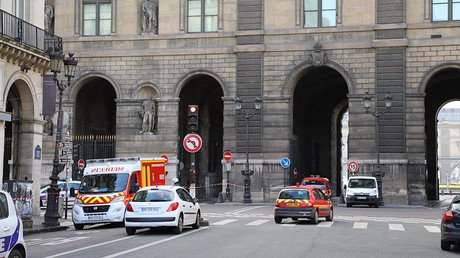Louvre attacker identified as ‘29yo Egyptian tourist’
Initial investigations into the Louvre attack have identified the suspect as an Egyptian national who arrived in Paris on a tourist visa from the UAE. The alleged terrorist wielded a pair of quite expensive ‘machetes,’ according to French officials.
One French soldier suffered a head injury in the attack. The machete-wielding suspect was shot and wounded and was later identified as a 29-year-old Egyptian national, according to Paris Prosecutor François Molins. He did not, however, disclose the name of the suspect.
Yet, according to AP, citing an interior ministry official, the perpetrator is a 28-year-old Egyptian-born man named Abdullah Reda Refaie al-Hamahmy. The source told the news agency that investigators have so far found no evidence of the man being involved in political activism, criminal activity, or any particular militant group.
In a Saturday interview with Dubai-based TV channel al-Hadath, the suspect’s father said he was shocked by the attack, AP reports. He told the TV channel that his son has a wife and a seven-month-old child. Al-Hamahmy apparently wanted to make a tour of Paris before departing from France.
The attack was “obviously of a terrorist nature” according to the French PM Bernard Cazeneuve. It is impossible to determine at the moment, if the suspect “acted on instructions” from abroad or if he acted “alone and spontaneously,” Molins told reporters.
There were some indications in the initial findings, though, that the attack might have been premeditated. The suspect arrived in France from Dubai on January 26 after acquiring a one-month tourist visa. On January 27, the attacker rented a car until February 5, and the next day bought two expensive machetes from an arms store near the Place de la Bastille, according to Molins.
“He bought two machetes from an arms store located near the Place de la Bastille of more than €600,” Molins said.
The suspect did not have anything else with him besides the pair of 40cm machetes, a “bag of paint cans” and a mobile phone when searched after being shot. Police traced his activity back to an apartment, presumably rented by the suspect, and the flat did not contain much either, according to Molins.
Investigators uncovered a sum of €965, the invoice of the two machetes, a number of prepaid sim cards, some clothes and an Egyptian passport stamped with visas for Saudi Arabia and Turkey in 2015 and 2016 respectively. The suspect also had a resident permit from the United Arab Emirates.
The attack at the Louvre occurred early on Friday when four soldiers prevented the suspect from entering Louvre shopping area with two bags. The suspect attacked them, bruising one soldier with the machete and was subsequently shot and wounded. The soldiers fired five shots in total. The attacker’s condition was described as “life-threatening,” but stable, and the injured soldier has been advised to take 10 days leave.
The group of soldiers belonging to the 1st Paratrooper Regiment was patrolling the Louvre as a part of ‘Opération Sentinelle’ – a nationwide security endeavor aimed at “protecting against and dissuading” attacks in France.













